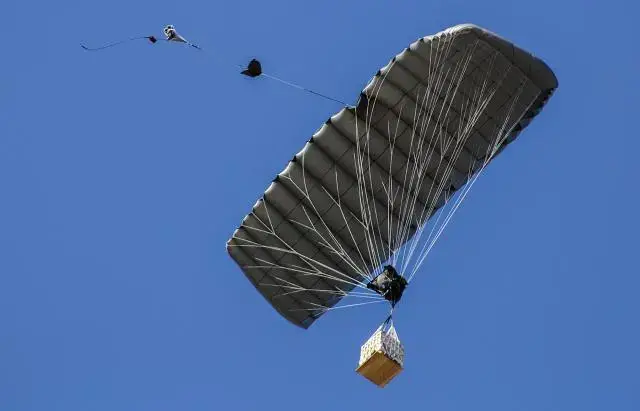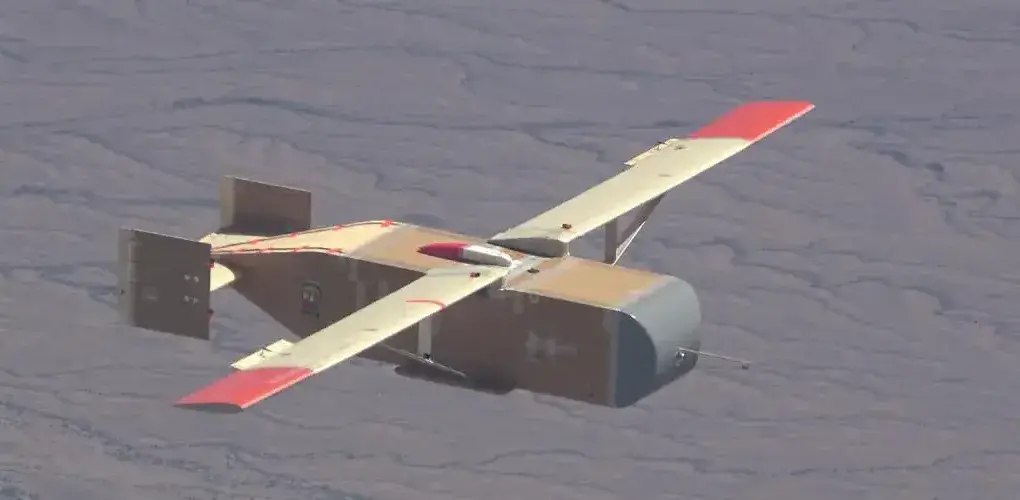Los elementos del US Marine Corps que se encuentran en operaciones en el Pacífico Occidental, deberán actuar en pequeñas fracciones aisladas de sus comandos y a muy grandes distancias. Cada abastecimiento a esas fuerzas, normalmente se realizan con aeronaves de carga o buques que deben atravesar zonas A2 /AD (Anti Access / Area denial) bajo control del enemigo, así como Weapons Engagement Zones (WEZ), lo cual afecta seriamente las lines a de abastecimiento, por las capacidades del enemigo de detectarlas, atacarlas y destruirlas. Para reducir esos riesgos, el citado Cuerpo ha desarrollado drones planeadores “Single – use”(Sin retorno), como plataformas específicas para misiones de aeroabastecimiento.
In the western Pacific, Marine Corps stand-in forces will operate as small units across vast distances. Every resupply of each unit will pose potential risks. To reduce them, the Navy–Marine Corps team should develop unmanned, single-use glider aircraft to support small-unit logistics.
The first risk for resupply in a distributed fight is the distance and time delivery boats and aircraft must spend within China’s weapons engagement zone (WEZ). Current methods would require an asset to penetrate the WEZ deeply. This poses a significant risk of detection for both the delivery platform and the stand-in force.1 Increasing the distance between forces is desirable in expeditionary advanced base operations (EABO), but it increases the risk of detection for the unit conducting resupply as well as the unit being resupplied. With an increased risk of detection comes a direct decrease in the value of the stand-in force. As the 2016 Marine Corps Operating Concept notes regarding future conflict: “To be detected is . . . to be killed.”2
Detection—and, therefore, destruction—of expensive and scarce resupply platforms would result in their attrition, only exacerbating the logistical problem. Present methods of resupply in the western Pacific require manned platforms such as surface vessels or rotary- and fixed-wing aircraft, a significant investment of resources and personnel. The loss of any single ship or aircraft would create a deficit that would not be immediately fixable.3 That loss would likewise reduce the capacity available for subsequent resupply missions. With each loss, the resupply problem would grow until the stand-in forces became isolated.
One way to mitigate detection is to create a harder target. Existing fixed- and rotary-wing platforms capable of aerial delivery are vulnerable to detection by a variety of means: audible compromise, visual acquisition, and heat and radar signatures.4 Each is cause for concern. The Marine Corps Warfighting Lab (MCWL) has been working on a tactical resupply system that could mitigate those problems.5
In 2015, even before the EABO concept was significantly developed, MCWL awarded a ten-month contract
to Logistic Gliders Inc. (LGI). LGI developed a prototype called the Tactical Aerial Delivery (TACAD) Glider.6 LGI is one of several companies offering covert, effective, long-range unmanned resupply.

LGI’s gliders can be launched from Marine Corps MV-22, CH-53, and KC-130 aircraft.7 After the initial success of the TACAD, LGI received additional contracts with MCWL and the U.S. Army Combat Capabilities Development Command (CCDC). Follow-on prototypes and test flights ran from 2016 through March 2020, when funding stalled. LGI’s LG-2K glider variant can carry a payload up to 1,800 lbs and as far as 70 nautical miles from its release point.8
Another candidate is the GD-2000 Glider, a disposable autonomous tandem-wing glider under development by Silent Arrow, part of Yates Electrospace Corporation. MCWL tested this system as far back as 2017, and, in March 2023, with the U.S. Army First Special Forces Group, conducted flight tests in Yuma, Arizona, under a Department of Defense contract.9 It can deploy from many of the same military aircraft as LGI’s gliders. It can be carried internally or sling-loaded and has an advertised capacity of 1,500 pounds at a range of 40 nautical miles. Other Silent Arrow models reportedly possess much longer ranges.10
Glider systems decrease the risk of detection by enemy forces. Released at a significant standoff distance from the supported unit, gliders could eliminate the risk of audible detection, and their small size and color scheme would decrease risk of visual detection.11 In addition, glider systems have low radar cross-sections and, because they lack engines, practically no heat signature, making them more challenging to detect and target.12 With a lower probability of detection comes an increased chance of successful resupply. Even so, despite a glider’s mitigation of radar and audible detection, the possibility of attrition by an enemy or natural events remains.
However, these gliders are being developed specifically with the goal of keeping costs low. In fact, the LG-1K and LG-2K prototypes produced by LGI are made at a price comparable to the Container Delivery System presently used for aerial delivery.13 Prototypes have an average cost between $4,500 and $11,000 and are intended to make a one-way trip.14 While Silent Arrow has not listed a specific unit cost, it says that the price points are roughly half those of Joint Precision Air Drop Systems (JPADS), or less than $16,500 if it is referencing the JPADS 2K.15
The low costs would ensure that future missions would not be jeopardized, even if individual gliders were lost. Releasing gliders in swarms also might increase the chance of success for at least some gliders. A 2019 study of the LGI system suggested that an “amphibious ship’s [aircraft] could deploy up to 50 gliders an hour because the MV-22 and CH-53 aircraft could carry multiple gliders simultaneously.”16 In addition, the inexpensive price of individual gliders means the swarms could include empty gliders as decoys, landing on uninhabited islands to deceive the enemy.
This idea is nested within A Concept for Stand-in Forces, released in 2021, which requires “small and plentiful vessels capable of connecting [stand-in forces] inside the contested area to distribution nodes outside the contested area, matched with multidomain decoys to deceive and slow adversary collections.”17 Inexpensive gliders would link the decoys and distribution nodes.
Furthermore, the gliders could be made from materials useful to Marines on the ground. The stand-in force might cannibalize a glider after it lands to use the parts to improve its position. For example, infrared scattering or blocking material could be used to build up overhead cover. Other materials might be fashioned into makeshift stretchers. All these options increase the value of the system’s disposable nature.
Even with all the possibilities behind unmanned glider technology, the Marine Corps might choose not to invest further in these systems. Some will question the cost-effectiveness of a single-use platform, and the Marine Corps prides itself on frugality; many Marines place value on equipment with enduring utility. In addition, other unmanned aerial vehicles (UAVs) in development are competing for the resupply role.
One such reusable system in development is Kaman’s KARGO medium-lift unmanned quadcopter. KARGO is intended to be a reusable, forward-positioned UAV eventually able to carry up to 1,000 pounds with a range of 500 nautical miles.18 Kaman describes the KARGO UAV as attritable, but it has not released cost data. A reliable, reusable UAV with the KARGO’s desired payload and endurance would be very useful, but the Marine Corps would have to consider the radar cross-section of a medium-size helicopter inside the enemy’s WEZ. Furthermore, a helicopter UAV the size of the KARGO produces an audible signature that may be detected on both its ingress and egress from the resupply point, endangering the stand-in force.
Modern research and historical precedent from World War II suggest that post-mission recovery of the gliders might be possible.19 While recovery may not be advantageous in all circumstances, if an inexpensive option existed for the necessary modifications, it would enhance the benefits of the glider program.
One-way, unmanned glider resupply vehicles could dramatically decrease the risks to distributed forces throughout the battlespace and free conventional manned delivery platforms for other missions. Silent, long-range vehicles for resupply would provide critical standoff options. With further refinement of existing technology, unmanned gliders should have the payload and endurance to give the Marine Corps an edge during distributed operations. The Navy–Marine Corps team should proceed with their development.
1. LtCol Branden G. Bailey, USMC, “Offsetting Tomorrow’s Adversary in a Contested Environment: Defending Expeditionary Advance Bases in 2025 and Beyond” (Air War College, 2017), 8.
2. U.S. Marine Corps, Marine Corps Operating Concept (Washington, DC: Headquarters U.S. Marine Corps, 2016), 6.
3. R. Derek Trunkey et al., The Cost of Replacing Today’s Naval Aviation Fleet (Washington, DC: Congressional Budget Office, January 2020).
4. U.S. Marine Corps, MCTP 3-40F: Distribution and Transportation (Washington, DC: Headquarters U.S. Marine Corps, 16 November 2020), 4-23.
5. Marine Corps Systems Command, Advanced Technology Investment Plan 2018—PEO Land Systems Marine Corps (Quantico, VA: Marine Corps Systems Command, 2018), 80.
6. Logistic Gliders Inc., “LG-1K and LG-2K Gliders,” datasheet, logisticgliders.com/downloads.
7. Martinus M. Sarigul-Klijn, Maurice P. Gionfriddo, and Nesrin Sarigul-Klijn, “Technology Demonstration of a 1-ton Single Use Disposable Glider,” American Institute of Aeronautics and Astronautics AIAA Scitech Forum, 6 January 2019.
8. M. Sarigul-Klijn, Gionfriddo, and N. Sarigul-Klijn, “Technology Demonstration,” 1.
9. Jared Keller “Green Berets Are Testing a Prototype Glider Drone for Speedy Resupply,” Task & Purpose, 31 March 2023.
10. Silent Arrow, “Silent Arrow for Resupply and Relief,” silent-arrow.com/tactical.
11. M. Sarigul-Klijn, Gionfriddo, and N. Sarigul-Klijn, “Technology Demonstration,” 2.
12. Sarigul-Klijn, Gionfriddo, and Sarigul-Klijn, 2.
13. Sarigul-Klijn, Gionfriddo, and Sarigul-Klijn, 3.
14. Sarigul-Klijn, Gionfriddo, and Sarigul-Klijn.
15. InfoBase Publishers Inc., “LI 9140MA7804 – Cargo Aerial Del & Personnel Parachute,” DACIS.com, March 2019, 3.
17. Gen David H. Berger, USMC, A Concept for Stand-in Forces (Washington, DC: Headquarters U.S. Marine Corps, December 2021), 22.
18. Megan Eckstein, “Kaman Unveils Medium-lift UAV to Resupply Distributed Marine Corps Forces,” Defense News, 20 September 2021.
19. Keith H. Thoms, “Snatch Pickup of Gliders from Naval Vessels,” Naval Engineers Journal 121, no. 2 (June 2009): 63.
Fuente: https://www.suasnews.com


